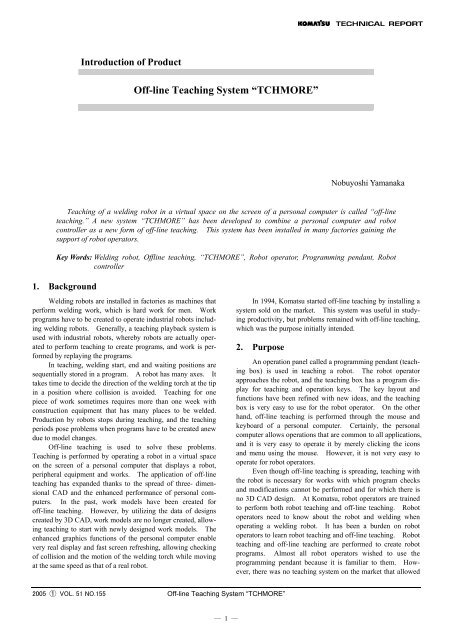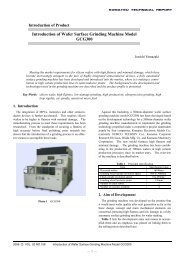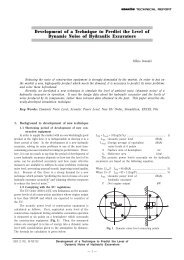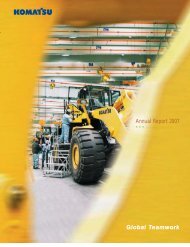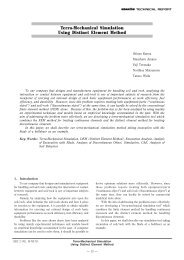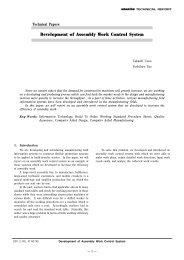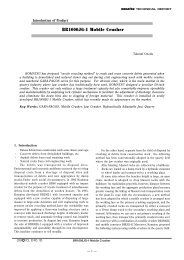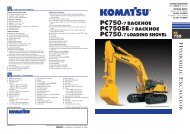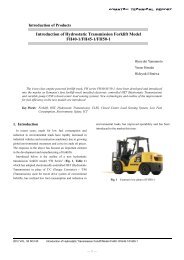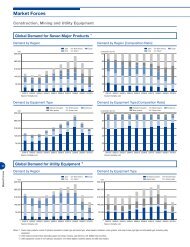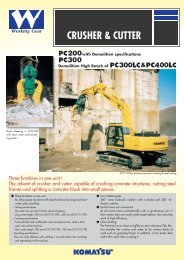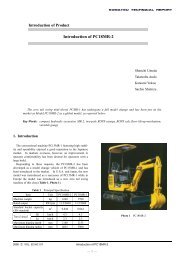Off-line Teaching System âTCHMOREâ - Komatsu
Off-line Teaching System âTCHMOREâ - Komatsu
Off-line Teaching System âTCHMOREâ - Komatsu
Create successful ePaper yourself
Turn your PDF publications into a flip-book with our unique Google optimized e-Paper software.
Introduction of Product<br />
<strong>Off</strong>-<strong>line</strong> <strong>Teaching</strong> <strong>System</strong> “TCHMORE”<br />
Nobuyoshi Yamanaka<br />
<strong>Teaching</strong> of a welding robot in a virtual space on the screen of a personal computer is called “off-<strong>line</strong><br />
teaching.” A new system “TCHMORE” has been developed to combine a personal computer and robot<br />
controller as a new form of off-<strong>line</strong> teaching. This system has been installed in many factories gaining the<br />
support of robot operators.<br />
Key Words: Welding robot, <strong>Off</strong><strong>line</strong> teaching, “TCHMORE”, Robot operator, Programming pendant, Robot<br />
controller<br />
1. Background<br />
Welding robots are installed in factories as machines that<br />
perform welding work, which is hard work for men. Work<br />
programs have to be created to operate industrial robots including<br />
welding robots. Generally, a teaching playback system is<br />
used with industrial robots, whereby robots are actually operated<br />
to perform teaching to create programs, and work is performed<br />
by replaying the programs.<br />
In teaching, welding start, end and waiting positions are<br />
sequentially stored in a program. A robot has many axes. It<br />
takes time to decide the direction of the welding torch at the tip<br />
in a position where collision is avoided. <strong>Teaching</strong> for one<br />
piece of work sometimes requires more than one week with<br />
construction equipment that has many places to be welded.<br />
Production by robots stops during teaching, and the teaching<br />
periods pose problems when programs have to be created anew<br />
due to model changes.<br />
<strong>Off</strong>-<strong>line</strong> teaching is used to solve these problems.<br />
<strong>Teaching</strong> is performed by operating a robot in a virtual space<br />
on the screen of a personal computer that displays a robot,<br />
peripheral equipment and works. The application of off-<strong>line</strong><br />
teaching has expanded thanks to the spread of three- dimensional<br />
CAD and the enhanced performance of personal computers.<br />
In the past, work models have been created for<br />
off-<strong>line</strong> teaching. However, by utilizing the data of designs<br />
created by 3D CAD, work models are no longer created, allowing<br />
teaching to start with newly designed work models. The<br />
enhanced graphics functions of the personal computer enable<br />
very real display and fast screen refreshing, allowing checking<br />
of collision and the motion of the welding torch while moving<br />
at the same speed as that of a real robot.<br />
In 1994, <strong>Komatsu</strong> started off-<strong>line</strong> teaching by installing a<br />
system sold on the market. This system was useful in studying<br />
productivity, but problems remained with off-<strong>line</strong> teaching,<br />
which was the purpose initially intended.<br />
2. Purpose<br />
An operation panel called a programming pendant (teaching<br />
box) is used in teaching a robot. The robot operator<br />
approaches the robot, and the teaching box has a program display<br />
for teaching and operation keys. The key layout and<br />
functions have been refined with new ideas, and the teaching<br />
box is very easy to use for the robot operator. On the other<br />
hand, off-<strong>line</strong> teaching is performed through the mouse and<br />
keyboard of a personal computer. Certainly, the personal<br />
computer allows operations that are common to all applications,<br />
and it is very easy to operate it by merely clicking the icons<br />
and menu using the mouse. However, it is not very easy to<br />
operate for robot operators.<br />
Even though off-<strong>line</strong> teaching is spreading, teaching with<br />
the robot is necessary for works with which program checks<br />
and modifications cannot be performed and for which there is<br />
no 3D CAD design. At <strong>Komatsu</strong>, robot operators are trained<br />
to perform both robot teaching and off-<strong>line</strong> teaching. Robot<br />
operators need to know about the robot and welding when<br />
operating a welding robot. It has been a burden on robot<br />
operators to learn robot teaching and off-<strong>line</strong> teaching. Robot<br />
teaching and off-<strong>line</strong> teaching are performed to create robot<br />
programs. Almost all robot operators wished to use the<br />
programming pendant because it is familiar to them. However,<br />
there was no teaching system on the market that allowed<br />
2005 1 VOL. 51 NO.155 <strong>Off</strong>-<strong>line</strong> <strong>Teaching</strong> <strong>System</strong> “TCHMORE”<br />
― 1 ―
operation by connecting a programming pendant to a personal<br />
computer.<br />
The off-<strong>line</strong> teaching system cannot execute all commands<br />
and confirm execution as the robot does. Commands<br />
that cannot be confirmed must be added using a robot, and this<br />
has been one reason that teaching robot operations has taken a<br />
long time.<br />
A new system, “TCHMORE,” was planned in an effort to<br />
solve these problems by modifying an off-<strong>line</strong> teaching system<br />
sold on the market. The development goal was robot operation<br />
using a programming pendant and confirmation of all commands<br />
of the robot as illustrated in Fig. 1.<br />
Fig. 1 <strong>Teaching</strong> to robot (left) and off-<strong>line</strong> teaching with<br />
“TCHMORE” Programming pendant (right)<br />
Functions more than offered by off-<strong>line</strong> teaching systems<br />
sold on the market are needed to accomplish this goal. The<br />
new system, “TCHMORE,” solved this problem by combining<br />
a personal computer and robot controller as shown in Fig. 2.<br />
The robot controller has a programming pendant, allowing<br />
robot operation and program editing. The same programs as<br />
those of the robot can be created and the same motions can be<br />
replayed. The robot controller drives the motors contained in<br />
the robot. However, the robot and the motors can be separated,<br />
and the robot on the personal computer can be operated<br />
by transmitting the positions of the motors to the personal computer.<br />
The personal computer displays the robot, works and<br />
peripheral equipment and operates the robot on the display<br />
screen when it receives the positions of the robot motors. The<br />
robot controller could be made compact containing only the<br />
printed circuit boards needed for “TCHMORE,” and the software<br />
could be developed by modifying it. The software<br />
modification could be performed in a short time. The personal<br />
computer software was developed in house to quickly<br />
meet in-house requests as programming simplified, parallel<br />
with enhanced graphics functions, allowing development by<br />
parties other than specialized software houses for CAD and<br />
game software.<br />
3. Features of “TCHMORE”<br />
3.1 Fast drawing and crash detection by<br />
DirectX<br />
DirectX that is mainly used in game machines is used in<br />
the 3D graphic processing of “TCHMORE.” A personal<br />
computer with the latest functions even if it is low priced can<br />
display equal to that in 3D CAD by installing a graphics board.<br />
Display of more than 20 fps (number of cycles to refresh the<br />
screen per second) is possible with almost all robot systems,<br />
and even weaving of swinging the welding torch at the tip of<br />
the robot left and right at several Hz can be confirmed.<br />
Even though robot motion can be viewed on the personal<br />
computer screen as if an actual robot in motion is being viewed,<br />
a robot crash cannot be confirmed visually on the personal<br />
computer screen, and a function to detect a robot crash and to<br />
notify the operator by personal computer processing is needed.<br />
Processing to detect the crash of objects is used in games and<br />
other applications 1) . However, this increases the load to the<br />
CPU, and screen refreshing is greatly delayed. In many cases,<br />
crash detection enable and disable is switched by the operator,<br />
and detection is enabled only when it is necessary.<br />
“TCHMORE” detects crashes by a unique method using a<br />
graphics board, and screen refreshing is not delayed even if<br />
collision detection is always enabled. Near crashes between a<br />
robot and piece of work can also be detected (Fig. 3).<br />
Fig. 3 Display of normal operation (left) and display of robot<br />
crash (right) Color of collided part changes<br />
3.2 Simulation of wire touch sensor<br />
The joint position deviates in the welding of thick plates<br />
as in construction machinery due to the thermal distortion of<br />
welding, and a wire touch sensor is used to detect joint positions.<br />
The wire touch sensor is operated by moving the robot<br />
as voltage is impressed to the welding wire. The robot<br />
motion is stopped when the wire detects contact with a piece of<br />
work. As shown in Fig. 4, in “TCHMORE,” a detection<br />
signal is output to the robot controller when contact with a<br />
piece of work by the welding wire in the display is detected by<br />
graphic processing. The robot controller stops robot motion<br />
as in robot operation when it receives a detection signal. This<br />
enables confirmation of operation of the wire touch sensor as<br />
in actual robot operation. The wire touch sensor can be made<br />
to approach or leave the work surface by a specified distance to<br />
input wire touch sensor commands.<br />
Fig. 2 <strong>System</strong> configuration of “TCHMORE”<br />
2005 1 VOL. 51 NO.155 <strong>Off</strong>-<strong>line</strong> <strong>Teaching</strong> <strong>System</strong> “TCHMORE”<br />
― 2 ―
Fig. 4 Usage of wire touch sensor<br />
3.3 <strong>Teaching</strong> correct welding posture<br />
The joint posture and welding torch direction can be<br />
decided as follows in teaching welding work. The angles are<br />
specified by numeric values, and a correct posture can be<br />
accomplished (Fig. 5).<br />
Fig. 5<br />
Welding torch posture is specified<br />
(1) A command is given to face the work joint down or<br />
horizontally, and the positioner with the piece of work on<br />
it is turned. A position to make the surface of a weld<br />
bead horizontal can also be specified by specifying a<br />
downward angle or upward angle and the unequal leg<br />
length of a fillet.<br />
(2) The welding torch is moved by moving the cursor to the<br />
welding start position.<br />
(3) The direction of the welding torch is decided by specifying<br />
the forward angle and aim angle of the welding torch.<br />
If the robot cannot move to the target position in 2),<br />
“TCHMORE” moves the traveling axes that slides the robot to<br />
automatically allow the robot to move. Similarly, if the robot<br />
cannot move in 3), the welding torch is twisted.<br />
3.4 Display of welding torch cable<br />
The welding torch cable attached to the robot sometimes<br />
curls around the robot depending on the robot posture. A<br />
program taught with the cable curled around the arm can be<br />
executed on a personal computer. However, when executed<br />
with a robot, feeding of the welding wire deteriorates, sometimes<br />
damaging the cable. Therefore, this program cannot be<br />
executed with a robot. Displaying a moving cable requires a<br />
large volume of calculations and is not practical. As shown in<br />
Fig. 6, “TCHMORE” displays a ring around the arm to simply<br />
show curling of the cable around the robot arm. A program<br />
without cable curling can be created by teaching a welding<br />
robot while checking the ring.<br />
Fig. 6 Cable not wound around the arm (top) and cable wound<br />
around arm (bottom) Display of cable winding<br />
3.5 Confirmation of program created<br />
All motions of a robot during execution of a program can<br />
be recorded using the capture function. The program step No.<br />
is also recorded in the case of a robot collision. After a program<br />
ends, the motion during the collision can be played back<br />
to confirm the motion and to modify the program (Fig. 7).<br />
A program whose execution time is long can be executed unattended<br />
during the night, and scenes can be checked the following<br />
morning using the capture function. Robot positions and<br />
program step Nos. are recorded, and records of about one hour<br />
can be saved in a small file of several MBytes by compressing<br />
data.<br />
Fig. 7 Scene of collision replayed by capture function<br />
A saved file can be fast replayed without connecting the<br />
robot controller. Files are used when studying program improvement<br />
in a group or when explaining the welding procedures<br />
of robots to <strong>Komatsu</strong>-affiliated plants outside Japan.<br />
3.6 Correction of machine errors<br />
The robot and positioner positions of old equipment often<br />
differ from the layout drawings due to a poor accuracy at the<br />
time of installation. “TCHMORE” is equipped with a function<br />
to correct machine errors by storing several reference positions<br />
of the positioner and jig in the robot through teaching.<br />
2005 1 VOL. 51 NO.155 <strong>Off</strong>-<strong>line</strong> <strong>Teaching</strong> <strong>System</strong> “TCHMORE”<br />
― 3 ―
This program is executed by “TCHMORE,” and positions are<br />
corrected by calculating differences. A special function to<br />
match the moving direction of the traveling axes and positioner<br />
revolution shaft is also provided (Fig. 8).<br />
Fig. 10 Torches fabricated<br />
Fig. 8<br />
Rotary axes of traveling axes and positioner<br />
are corrected<br />
3.7 Layout examination<br />
“Layout study” means studying the layout of a robot,<br />
positioner and works and is performed before installing new<br />
equipment or welding new works. In a layout study of<br />
“TCHMORE,” a robot controller does not have to be connected,<br />
and another personal computer can be used. The<br />
following functions have been added for layout study.<br />
(1) Moving the cursor to the welding torch and dragging it<br />
moves the welding torch in the dragging direction (Fig.<br />
9). Using this function, the area in which the robot<br />
moves can be checked.<br />
(3) Whether or not welding is possible is checked by operating<br />
the robot. Positions of the robot can be recorded and<br />
played back. The position data can be saved in a file<br />
and can be played back during teaching.<br />
4. Principal specifications<br />
“TCHMORE” is compatible with robots manufactured by<br />
<strong>Komatsu</strong> and Yaskawa Electric Co. (Fig. 11). The<br />
“TCHMORE” specifications are presented in Table 1.<br />
Fig. 11 “TCHMORE” compatible with KXRC (XRC)<br />
Table 1 Specification of “TCHMORE”<br />
Fig. 9 Robot operation by mouse<br />
(2) The robotization rate fluctuates depending on the shape<br />
of the welding torch. “TCHMORE” can create the<br />
welding torch to select the optimum torch and to study<br />
the torch mounting position (Fig. 10). Several torch<br />
types can be selected, and the torch size and mounting<br />
position can be changed through numeric input.<br />
Controller<br />
Robot<br />
Personal Computer<br />
Controller<br />
Item CXX KXRC<br />
Hardware<br />
<strong>System</strong><br />
software<br />
I/F<br />
Software<br />
protection<br />
Configuration<br />
Housing<br />
Compatibility<br />
Seller<br />
CXX manufactured by<br />
<strong>Komatsu</strong><br />
Floor mounted/ceiling<br />
mounted type<br />
KXRC manufactured by<br />
Yaskawa Electric<br />
(MOTOMAN XRC)<br />
Floor mounted/ceiling<br />
mounted type<br />
Cable embedded<br />
Intel Pentium IV 2GHz or its equivalent, or higher<br />
Memory capacity 128MB or more<br />
Graphics board compatible to DirectX8 or newer<br />
Windows Me/2000/XP<br />
DirectX9 or higher<br />
RS232C×2<br />
Parallel I/O 8 points or more<br />
Aladdin HASP(USB key)<br />
Servo amplifier not installed yet<br />
Printed circuit board interchangeable with robot<br />
installed<br />
Programming pendant installed<br />
Special box (manufactured by <strong>Komatsu</strong> Engineering)<br />
<strong>Komatsu</strong> CX<br />
MOTOMAN NX<br />
(converter software)<br />
<strong>Komatsu</strong> Engineering Co.<br />
2005 1 VOL. 51 NO.155 <strong>Off</strong>-<strong>line</strong> <strong>Teaching</strong> <strong>System</strong> “TCHMORE”<br />
― 4 ―
5. Delivery records of “TCHMORE”<br />
All the main plants of <strong>Komatsu</strong> in Japan use<br />
“TCHMORE” for the off-<strong>line</strong> teaching of welding robots.<br />
“TCHMORE” is being installed at <strong>Komatsu</strong> group companies<br />
and local corporations of <strong>Komatsu</strong> outside Japan. At present,<br />
the following units of “TCHMORE” are installed.<br />
◦ <strong>Komatsu</strong> plants in Japan<br />
11 units<br />
◦ <strong>Komatsu</strong> plants outside Japan 3 units<br />
6. Future plan<br />
“TCHMORE” was readily accepted by robot operators<br />
because the same programming pendant as that used in robot<br />
teaching and off-<strong>line</strong> teaching can be used. “TCHMORE” is<br />
intended for teaching, but also enjoys a high reputation as a<br />
training tool for robot operators.<br />
<strong>Komatsu</strong> plans to construct a database for welding conditions<br />
and program standardization in cooperation with the<br />
plants of <strong>Komatsu</strong>. Technical problems such as creating loci<br />
to avoid collisions will be solved to create automatic programming<br />
that requires no teaching, as has been accomplished in<br />
other industries 2) .<br />
References:<br />
1) ABC of 3D Game Programming, Impress, 2000.<br />
2) J. of Japan Welding Society, Vol. 74, No. 5 (2005) pp. 372<br />
- 382<br />
Introduction of the writer<br />
Nobuyoshi Yamanaka<br />
Entered <strong>Komatsu</strong> in 1983. Currently belongs<br />
to Manufacturing Engineering Development<br />
Center, Production Division<br />
[A few words from the writer]<br />
Almost all the features described above have been realized by<br />
listening to the wishes of the robot operators in the <strong>Komatsu</strong> plants.<br />
The writer thanks these robot operators in the plants who have<br />
contributed their wishes and improvement suggestions to the initial<br />
version of “TCHMORE,” which had no plausible functions<br />
except allowing robot operation by a programming pendant, without<br />
giving up “TCHMORE.”<br />
2005 1 VOL. 51 NO.155 <strong>Off</strong>-<strong>line</strong> <strong>Teaching</strong> <strong>System</strong> “TCHMORE”<br />
― 5 ―


